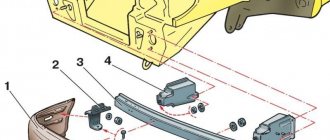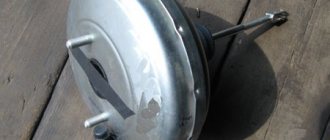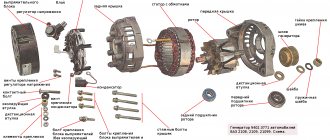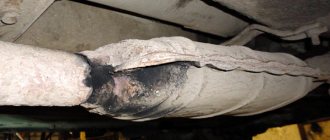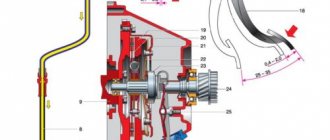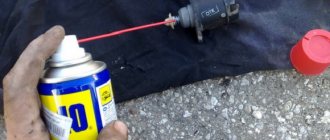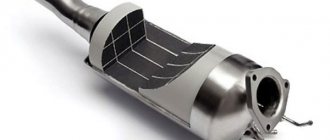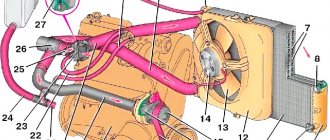Wheel arches are the most exposed part of the car to mechanical stress. Nevertheless, some motorists are confident that the factory protection can fully cope with its responsibilities. Others are absolutely convinced of the need to take additional measures to protect the metal of the wheel arches, otherwise in a few years, as a result of driving on domestic roads, they will receive damage “incompatible with life.”
Let's figure out which one is right.
Wheel arch protection: why is it needed?
Stones and other objects flying out from under the wheels, driven by centrifugal force, rush upward, where they are met by the inner surface of the wheel arch. As you know, water wears away stones. In this sense, metal is a more pliable material for stone. But it's not only that. Modern anti-corrosion treatment copes quite well with such mechanical stress, while simultaneously protecting the metal from corrosion.
But if chemical factors come into play (remember winter reagents for ice), such protection turns out to be powerless. That's what fender liners are for.
Many automakers install their own protection on wheel arches. This is usually a thin plastic that breaks down over time under the influence of gravel, sand, screenings, salt and other factors. So the question of why you need to install fender liners on a car is still quite relevant, especially for older cars. Car owners just need to carefully monitor the condition of the inner cavity of the wheel arches (as well as the bottom), and if it gives rise to concern, take measures to avoid further destruction.
There is no better way to do this than installing additional protection. Therefore, let's look at what fender liners are, what they are like, and how you can install them yourself without resorting to the help of car services.
Tags: installing factory fender liners without screws and extra holes in the body
Comments 56
What perversions did you see?
the type of fender liner itself
I also set these for myself in the summer at 9k)
Somehow I found where to buy them)
Hi, what kind of fender liners are these?
Hello, the wheel arch liners from the VAZ 2114 are factory.
the plasticine will melt in the summer, cover it with a transparent silicone sealant, the fender liners are shaped like foreign or something, to me they’re like the factory fender liners for 2108, my wings are plastic, I don’t care about the cutter
I bet regular plasticine will melt, but auto plasticine will be just elastic
Wow, this is a useful post. I’ve had these fender liners lying around for two years now, I tried them on once, they didn’t fit, I thought for a long time about how to install them. I'll take note. Thank you!
You're welcome, installation is very simple and quick. Of course you'll have to cut off the excess
Good job, but there is one BUT, will this plasticine fly off the first time you wash the car? In my rear, almost all the anti-corrosion protection in the arches was knocked off at the car wash.
Thank you. The plasticine will not fly off, it holds very tightly. Once upon a time it was smeared on my 9, drove for 5 years, did not fly off
Read more: Winter tire sizes for Tiguan
Good job, but there is one BUT, will this plasticine fly off the first time you wash the car? In my rear, almost all the anti-corrosion protection in the arches was knocked off at the car wash.
Don't worry, it won't fly off. I have a couple of holes in the door sealed with it, and it will be fine for almost a year now. At the car washes, even the spray paint applied to it didn’t come off =)
Do you need regular car plasticine or some special one? Does it harden or stay the same soft?
I had some kind of blue box lying in my garage with the inscription “Autoplastelin with a rye converter.” They all seem to be like that. No, it remains plastic for the entire time of use. Moreover, this crap was in my garage for at least 7 years; it was still used in my father’s seven.
ok topic, I already bought a car with these
Thank you. It’s good that I already bought with these
They also make cars from this plasticine! hahahaha))))
What really holds up well? Will it come off metal normally?
Plasticine do you mean?
I used plasticine to fill small gaps between the wing arch and the fender liner so that dirt and water would not get in. In fact, I did not use the plasticine to hold the fender liner, but it rubs off the metal perfectly.
first time I heard about these
I myself found out not long ago that such things exist.
I would like the discs to be unwelded
I respect competent work, but I would just like to add from my personal experience I bought a fresh four and it wasn’t even a year old and these factory fender liners were standing there, in general, I was riding until after washing I noticed that in the part where the open space, or rather where the fender liner does not cover, there is a dent and also about 1.5 cm of metal was torn apart and it was all due to a stone that jumped out from under the wheel! I spat on everything, removed them, removed the metal rupture, processed them and installed those that completely cover the entire space, naturally, having sealed everything, only instead of plasticine I used silicone! But thanks for the tip with plasticine, autumn will come, I’ll take pictures of everything and then I’ll use plasticine. I set the task that every year I will monitor what’s happening there! Good luck on the roads
Thank you very much, mutually. I’ll take note and monitor what’s happening under the fender liners.
Types of fender liner
There are several ways to protect car arches. Let's look at the most popular and widespread of them:
- plastic fender liners. Lockers made of soft plastic replaced metal fender liners, which were very common in Soviet times. They had a good resource, but were heavy and inconvenient to install. Plastic products have lost these shortcomings, being practically inferior to them in terms of mechanical strength. They are much more elastic, lighter, characterized by high wear resistance, and easy to install. In retail there are products of various shapes, designed for almost all domestic models and most foreign cars. And the cost of plastic is much lower than metal. Their main drawback is the need for fastening to metal using self-tapping screws - even if this area is treated with an anti-corrosion compound, over time this is where a rust spot can form;
- Fiberglass fender liners in their characteristics are not much different from plastic ones - their light weight, strength and immunity to temperature and atmospheric factors make them a good, albeit more expensive, alternative to plastic;
- liquid lockers have long become the de facto standard when applying an anti-corrosion/anti-gravel layer in a factory environment. You can create such an additional one yourself, using the appropriate liquid, of which there is an abundance in the retail chain. The main advantage of liquid lockers is the ease of processing any pre-cleaned surface, regardless of their geometry. The disadvantage is also quite obvious - the fragility of the coating (average service life is 2-3 years);
- armoring film is a type of metal protection that appeared relatively recently. However, in factory conditions the technology has already proven itself on the positive side; it is used to protect all body parts exposed to external influences: bumpers, sills, optical instrument lamps. The strength qualities of such films are no worse than plastic, plus they are transparent, that is, they do not spoil the appearance of the car. The only significant drawback is the complex application technology;
- fender liners made of ABS plastic have approximately the same set of pros and cons as regular polyethylene - with low weight and cost, they are not very durable, and also have low weather resistance. They are not recommended to be pressed too tightly against the arches due to the risk of cracks; the overall service life of such products is low;
- Aluminum lockers, as well as galvanized ones, are practically not used today. Despite their high mechanical strength, they have a number of disadvantages (the need to use a rubber gasket, the risk of bursting at the fastening point or being subject to deformation).
Why change fender liners?
There are several reasons that may prompt you to replace the wheel arch liners on your VAZ 2114.
- Old car wheel arch liners have lost their effectiveness and burst. They simply fell into disrepair, so new arched elements are simply necessary.
- These are products that perform the role of protecting the body from corrosion and premature rust formation.
- The fender liners additionally protect the underbody, or rather the wheel arches. This is perhaps the weakest point of the car's underbody.
- The so-called sandblasting effect is reduced. Sand is an integral part of any road. There is a certain amount of it almost everywhere. This sand, falling under the car, increases the speed of its wheels. As a result, sand literally hits the car from below, destroying all protective redoubts over time.
- Reagent protection. As you know, in winter the roads are covered with snow and ice. To prevent multiple accidents and accidents, roads need to be cleared. Ordinary shovels and tractors are not enough here, since a layer of snow still remains. Special reagents or even ordinary salt dissolve snow and ice, making roads safe and non-slippery. Unfortunately, these reagents have a negative effect on car bodies, leading to corrosion and rust formation. The fender liners protect the car from them quite effectively.
Fastening elements
Only liquid lockers do not require the use of fasteners. All their other varieties need to be fixed and secured somehow. Different manufacturers handle this differently. Thus, domestic car factories prefer to use self-tapping screws, while Asian car manufacturers use both self-tapping screws and clips. In the USA, plastic clips are mainly used, while in the Old World many types of fasteners are used.
Let's look at all the common ways to attach fender liners:
- clips are used to attach not only the fender liner, but also other parts of the body and interior (for example, trim). An alternative name for this type of fastener is a spring clamp. There is a reason for this name: fixation occurs due to the expansion of the cut part of the clip after its installation;
- latches, like clips, do not provide ideal fastening rigidity, but their main advantage is a non-traumatic installation method, used mainly for rigid types of fender liners (fiberglass, ABS plastic);
- self-tapping screws are the easiest to use, have a longer service life, but leave behind holes in the body part. It is recommended to use only galvanized products, and treat the fastening area with an anti-corrosion compound;
- Pistons can also be called a common and universal method of fastening automotive parts. The fixing ability remains high even in cases where the piston does not completely enter the hole;
- bolt + nut – a type of threaded fastening, characterized by high reliability of the connection and its low aesthetics. Requires anti-corrosion treatment.
Instructions for replacing and repairing fender liners
It is recommended to carry out work when the car is jacked up or placed on a lift. The wheels are removed and dirt deposits are removed from the arches. Each spare part is tried on at the installation site. The fender liner must fit exactly in the arch. The fastening method will depend on the shape and design of the products.
On passenger cars
To install the fender liner, you will need a Phillips screwdriver and a utility knife.
- Before starting work, it is advisable to take the car to a car wash. The main task is to thoroughly wash the areas under the wings.
- Dismantling wheels and old products - all screws and clips are removed.
- The attachment points and the space under the wing are cleaned. All moisture and dirt are removed from the entire surface. The wheel arch can also be wiped with a degreaser.
- The new locker needs to be prepared for installation. Pre-fitting is done. If excess protruding parts are found, they should be removed with a utility knife.
- The fender liner is fixed, the fasteners from the kit are distributed, inserted into the appropriate holes and tightened.
There shouldn't be any difficulties during the installation process. You should slowly understand all parts of the structure and carry out installation. If the installation is done incorrectly, you will have to do everything again.
On trucks
Lockers are installed on trucks and trailers according to the same principle as on passenger cars. For installation you will need an electric drill and galvanized screws with wide heads. The installation method will depend on the type of fender liner, they come standard with a sleeping bag and without a sleeping bag. You should pay attention to whether there are specially designated places on the car for installing lockers.
Noise insulation
Wheel arches, along with the engine compartment, are one of the most accessible places in terms of penetration of external noise into the cabin. Usually, the sound insulation of the engine compartment is done at a good level, so the sounds of a running engine practically do not reach the inside of the car. Another thing is the arches, which perfectly convey the acoustics of the tires. So, along with installing anti-corrosion and anti-gravel protection, you should also think about additional sound insulation. There is also a considerable selection of means and methods, from liquid materials to special sealants. You can also purchase fender liners with a sound-absorbing coating already applied.
We insulate the wheel arches to reduce noise in the cabin
There are literally dozens of options for soundproofing wheel arches. Many use traditional methods with the installation of insulation of various shapes and options, others prefer more modern solutions. In any case, you should remember about the effectiveness and durability of the chosen sound insulation method. You can choose to spray special chemical compounds on the fender liner, which will be done for you in a specialized center. You can also use the ideas of liquid sound insulation in the form of various resinous compounds applied to the metal in a thick layer. However, the most popular solution is this method of soundproofing car arches:
- in a car store or on the market, a search is made for the optimal materials for sound insulation specifically for your car or universal ones;
- the material in this case is a foil and fairly thin seal that should cover all metal surfaces above the wheel;
- the material is mounted on mastic, as well as on special glue or other fasteners, which also reduces the possibility of corrosion;
- sound insulation can be single-layer or multi-layer; often the effectiveness of all work performed depends on the number of layers of material;
- the sound insulator is mounted with the foil side to the wheel, this helps to reflect sound and reduces unpleasant noise effects in the car interior;
- A plastic fender is mounted on top of the insulation layer - this is a prerequisite for maintaining the durability of the insulation layer and the efficiency of its operation.
The process of installing sound insulation on fender liners is quite simple, so you can complete all the tasks yourself. Many sellers offer ready-made plastic fender liners with a layer of sound insulation and insulation applied. This is a completely adequate solution, but its effectiveness is somewhat lower than when carrying out high-quality insulation using special materials. You can use a variety of solutions to get the desired result. The main task is to ensure reliable protection of the body from the spread of corrosion. This is one of the first tasks when performing any work related to the installation of additional materials or devices. Therefore, it is recommended that work be carried out by specialists.
What is needed to install the fender liner
It all depends on the type of lockers used. So you need to start with their selection. In the retail chain they are presented in sets, but you can purchase fender liners separately if necessary. Original products are expensive, but they are easy to install in a seat; in this case, there are no compatibility problems, unlike analogues.
What you will need besides lockers:
- soundproofing material. The most common is vibroplast, which, in addition to soundproofing properties, will protect the body from moisture;
- material for anti-corrosion treatment of those places where fasteners are used or where the locker comes into contact with the body;
- construction hair dryer - used to cover the arch with vibroplast, to preheat some types of lockers, especially non-original ones;
- fastening the fender liners (screws, clips, latches). Using clips, you can attach lockers to plastic bumpers, self-tapping screws are used for fastening to metal body parts.
What happens if you don't put fender liners on your car?
There are a number of negative factors that can arise if there are no fender liners on a car. We've already talked about some of the disadvantages, but now it's worth collecting them all into one list of specific disadvantages. There are many opinions about plastic fender liners, including among experts. Many will say that this part is not needed at all and is a big drawback of a modern car. Others will say that without the use of high-quality fender liners, your car will not be able to drive on our roads for even a year, remembering the salts on winter asphalt and various bitumen mixtures. The main reasons why many motorists install fender liners on their vehicles are the following:
a significant reduction in the risk of corrosion on the wheel arches, which significantly increases the reliability of the vehicle and its durability; reducing noise in the car interior from the arches, which is especially important at high speeds when traveling on the highway or when operating the car on difficult roads; there is significantly less risk of chipping the paint or protective layer of the body when driving on gravel and sand, certain protection of metal parts from destruction; addition to the appearance of the car - without fender liners the car looks unfinished, some details and voids are visible that spoil the appearance; When washing a car, it will be much more difficult to pour water into places where it is not needed, this will significantly increase the operating comfort of the car.
Less important advantages of using modern versions of fender liners are also mentioned. You can recall the special anti-noise compounds that are applied to the wheel arches only when installing fender liners. The use of modern fender liners with various installation options and convenient operation will improve the quality of use of your car and extend the potential life of the vehicle in order to save money on repair and restoration work. There are dozens of ways to install fender liners; their choice and purchase also turn out to be different for each buyer. Therefore, choose the options that are convenient for you, but do not leave your car without this protection option. We offer a short video on how to install fender liners on one of the popular cars:
Do-it-yourself fender liner installation algorithm
Installing lockers on the front arches is in most cases a simpler operation. The reason is simple - there are more opportunities to install fender liners without screws. We will try to describe how to do this. The task is simplified by the ability to attach a plastic bumper to the side edge, which on most modern models is adjacent to the wheel opening. It is clear that the risk of corrosion in this area is reduced to zero. In addition, lockers can be installed in existing grooves; in this case, additional fixation is often not needed at all. Another simple option is to attach the fender liners to the mudguards; in this case, self-tapping screws can be used in the area of the arch pillar, where the metal of the body is well protected.
Installing rear lockers is more difficult:
- you need to start by trying on the fender liner and trimming the protruding parts;
- then you should prepare the metal surface (free it from dirt and rust) and immediately treat it with mastic or another similar substance;
- Now it’s time to start installing the locker. If you cannot do without self-tapping screws, try to minimize their number without compromising the strength of the connection;
- try to use plastic fasteners (clips, pistons, latches) where possible;
- If you have doubts about reliable fixation, you can carefully glue the fastening points.
Over time, the lockers, which initially do not have a gap with the body, may move away, so this must be monitored during operation of the car. If such places are discovered, it is necessary to urgently take measures aimed at eliminating the deficiencies. Otherwise, the cracks will inevitably become a place for the accumulation of dirt and moisture, that is, a source of corrosion.
Advice from experienced drivers
- To eliminate the relief discrepancy, during installation, individual sections of the plastic are deformed by heating them with a high-temperature hair dryer. If the fastening is done correctly, the tire should not touch the wheel arch protection even at maximum wheel inversion.
- If the area of the wheel arches is already rusty, then after cleaning it needs to be primed with anti-corrosion agents, for example “ML”, “Movil”. The composition protects exposed metal in holes from the corrosion process. For the same purpose, during installation, screws should be screwed in, having previously treated them with sealant.
Read more: Converting kva to kW
Most products have point protrusions - this greatly simplifies installation, which can be done without distortions. If the fasteners are not performed correctly, some areas of the body will remain unprotected. According to reviews from consumers and sellers, the warranty on fender liners corresponds to their shelf life - 5-8 years.
Hi all.
Denis and I decided to install fender liners from the 14 for me. I couldn’t find any information about the installation on the Internet.
I decided to share my personal experience with you, maybe it will be useful to someone.
Today Denis and I completed the installation of fender liners on my car.
We installed standard wheel arch liners from 14 in 2109. There seemed to be no difficulties with the installation. The installation took three evenings for two hours. First evening.
I went to the car wash, washed the whole car, special emphasis was placed on washing under the wings. After washing, I went to put the car in the garage. That same evening I removed the front wings. To wash off any remaining dirt, dry everything. Apply a little mastic in the right places if required.
Sequencing
We will assume that all preparatory work (wheel removal, washing, anti-corrosion treatment) has been completed. The plastic fender liner purchased in the store needs to be modified - you need to cut off the horizontal side edge, which is located near the outer side of the arch, leaving a side 7 mm wide. This side, that is, the remaining part of the protruding edge, is “recessed” into the profile slot. The lower rear part of the fender liner is tucked under the bumper. So, from this part of the part the edge is cut off completely (a 7 mm wide edge is not needed here).
Rear plastic fender liners after installation
You can install the rear fender liners by following these steps:
- The plastic shield that protects the bumper from dirt is dismantled, and the screws that secure the bumper to the arch are also unscrewed;
- The rubber profile is placed on the fender liner along its entire length, starting from the lower front corner;
- The fender liner is installed in its rightful place, tucking the metal side of the arch into the slot, and the rear part of the fender liner goes into the gap between the bumper and the surface of the arch;
- At the installation points of the self-tapping screws that secured the bumper, the fender liner needs to be drilled with an awl;
- The bumper mount is restored;
- The shield is being installed.
At the final stage, it is recommended to push the plastic inside the arch with your hands, drill a hole near the corner of the fender liner and screw a self-tapping screw into it. And to protect the metal from rust, you can use silicone sealant.
Preparation, sound insulation
Protecting the arches begins with washing the inside of the mudguard and thoroughly drying it. Then the entire surface is degreased. Option for good sound insulation of wheel arches:
- A vibration-absorbing layer is glued onto the entire surface of the mudguard, covered by the locker you purchased (for example, Shumoff L3 or M3. It needs to be heated before pasting). The sheets are rolled tightly with a metal roller. In this case, the standard anti-gravel coating does not need to be removed;
- Mastic is applied on top with a brush or spray. If desired, you can put it in 2-3 layers, but at the same time, allow 10-15 minutes of drying between layers. at a temperature of +20ºС;
- plastic lockers are covered with noise-absorbing material (for example, Shumoff Germeton A15). Also at this stage, soundproofing sheets based on foam rubber can be used (as an option - Shumoff Comfort 6).
Noise insulation of wheel arches
